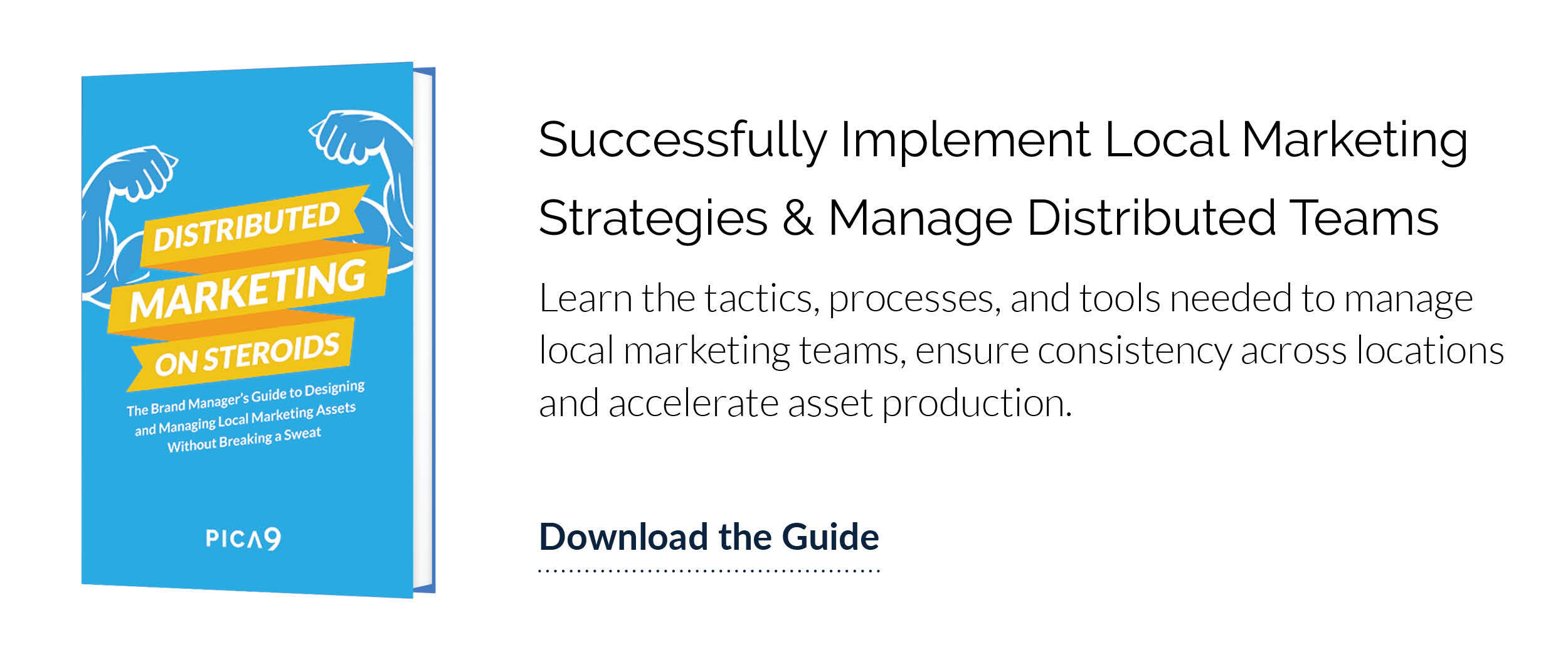Marketing at a distributed organization is a bit like playing telephone. The head office marketing team creates a strategy, they share that strategy with the brand management team and brand managers share the strategy with their local outlets. There are a lot of moving pieces, and traditional marketing communication methods often break down with a distributed marketing model. Not only are brand managers at distributed firms working to support a global or national team of local partners, they have to navigate some pretty intense marketing challenges.
The idea of a distributed brand has evolved slightly in recent years. It’s been adopted by a growing remote workforce - corporations or startups with employees scattered all over the globe. While these companies are definitely dispersed and maybe even decentralized, they’re not truly distributed brands. Here's why.
What is a Distributed Brand?
This article is for you if you can answer “yes” to the following questions about your company:
- People in charge of branding are not always in charge of execution
- People in charge of execution on a local level are not experts at branding/marketing
- People in charge of execution on a local level have diverse requirements for marketing assets
- People in charge of execution on a local level outnumber people in charge of branding (usually by 10:1)
- Branding is critical to the success of the organization
Distributed brands can include franchised organizations, dealership networks and other businesses with a network of affiliates. They span multiple industries, from fast-and-casual dining to pet supplies to banks. What all of these organizations have in common is the need to get assets into the hands of local outlets fast.
Distributed digital asset management (DAM) is a tool with the potential to make brand management much easier. Read on to learn how distributed DAM is a problem-solving powerhouse for local marketing.
To delve deeper into the world of DAM, we recommend additional resources from the Pica9 archive:
The 5 Best SaaS DAM Tools of 2017
Gartner Includes CampaignDrive by Pica9 as Example of Distributed DAM in Market Guide
How to Streamline Your DAM Workflow & Improve Marketing Efficiency in 6 Easy Steps
Brand Managers Have More than 99 Problems, But Digital Assets Don’t Have to Be One
There are many things that a distributed DAM tool cannot solve. It can’t give anyone on your team an MBA or marketing degree overnight. It can’t act as on-site monitor of compliance in the field. However, it can act as a mediator between your brand management team and your local marketers.
Whether you operate a distributed brand in the financial industry or the restaurant industry, a DAM helps with the following problems:
- Tension around who has control of the marketing campaign messaging.
- Worries that brand standards are not being protected.
- Slow execution of marketing campaigns.
Distributed DAM Structure
There are a few different categories of DAM, offering specific solutions based on the industry and business model. Don’t try to make a DAM that was built for giant media companies fit into your distributed brand's marketing technology stack. Unless you want to get into a full-scale custom development project to make the DAM fit your company's needs, you'll be better off with a solution that’s obviously tailored the needs of a distributed brand.
When it comes to enterprise software selection mistakes, two of the most common reasons technology fails to work as intended are:
- The company didn’t know their requirements.
- The company didn’t fully understand their requirements.
If you don’t understand what your marketers, designers, and local affiliates need from DAM, you won’t achieve adoption. If you don’t understand how much control you need over key features, like locking certain template elements and opening others up to edits, you’ll be disappointed in the day-to-day results.
Accommodating All Your Content
A DAM needs to fit your organization's marketing mix. Local marketing execution is rarely digital-only. Even if your advertising occurs primarily on the web, your franchisees or local outlets are probably still using print materials in-store. Your DAM should provide accommodation for every kind of collateral your brand needs to provide to the local marketers; which may include a mix of digital files, print files, email templates, audio, video, and more.
Support for Local Marketing Execution
DAM should make your brand management teams’ jobs easier by providing workflows for creating marketing templates. Through these templates, head office should be able to exert the right balance of control and freedom for your local partners' campaign creation.
Distributed DAM makes it easier and faster for your local partners to execute marketing. The beauty is in the real-time execution that DAM enables - it takes only minutes for locals to transform brand-provided templates into localized marketing materials. With the click of a button, they can order prints and banners. No more sending designs back and forth.
DAM execution potential is largely driven by ease-of-use. In fact, seminal research in the information systems field has found that perceived ease-of-use is one of the biggest reasons platforms gain regular users in an enterprise business. Actual ease-of-use is less important than perception; your users need to think it’s simple. With a DAM geared toward distributed teams, it's easier for brand managers to demonstrate the tool in relation to the needs of the local outlet.
Your distributed DAM needs to provide a clear improvement over your local outlets' old way of doing things. You’ve found the right DAM when your local marketers want to use it to create advertising.
Industry-Specific Requirements
If your organization is in an industry that’s not heavily regulated, count yourself lucky. Your distributed DAM options are less limited than highly regulated counterparts. If you’re in the business of finance, healthcare, or any other highly regulated industry, proceed with caution and keep compliance in mind.
For distributed brands operating in highly regulated markets like health, finance, or for-profit education, you’ve got some serious specs to keep in mind. Your marketing technology, including DAM, should provide support for your compliance efforts. This can include the required disclosures you need to avoid trouble with the SEC or other regulatory bodies, a workflow that accommodates your internal legal review, or any other accommodations for how your organization needs to approach asset creation.
Ease of Implementation
There are plenty of stories of brands that have hacked and modified very generic content management systems to operate more like a DAM system. While their creativity is admirable, custom building or designing a DAM from a general platform is going to be a time-consuming endeavor - especially if you have assets in the hundreds of thousands. If your organization is struggling to manage your marketing collateral, you need a DAM that fits your workflow requirements for ease-of-implementation.
Some enterprise technology implementations can take months. Selecting a SaaS option speeds things up significantly, especially if you’ve got a goal of getting up in running within weeks. Lightweight, cloud-based platforms offer agility, which is a bonus if your branding team wants to spend time perfecting the system internally.
Finally, your organization should be in control of your DAM, not the vendor. Your vendor should be responsible for all the technical tweaks that you don’t really notice, like software updates and maintenance. You can’t be dependent on your vendor to upload your creative assets, especially since marketing execution needs to occur quickly.
Don’t Invest in the Wrong Tool for Distributed Digital Asset Management
Distributed brands face unique challenges on the road to marketing execution. You’ve got to navigate a confusing system of internal approvals, competing priorities, and vastly differing skill levels to get a campaign concept in front of your future customers.
Your DAM system needs to provide an easy mechanism for your brand team to organize digital assets. More importantly, your DAM needs to provide an easy, appealing way for your local partners to advertise their businesses using marketing collateral provided by your brand management team.
With a lightweight, SaaS-based tool designed for distributed DAM, your brand management team can avoid the cost and stress of a months-long implementation processes or headache-inducing custom workflow creation. When you’ve got enough on your plate, a tool that’s built for distributed models can allow you to start winning quickly.
For more original research on distributed DAM, we recommend the free Guide to Distributed DAM: The Market Guide to Digital Asset Management with Original Research from Gartner, Inc.




